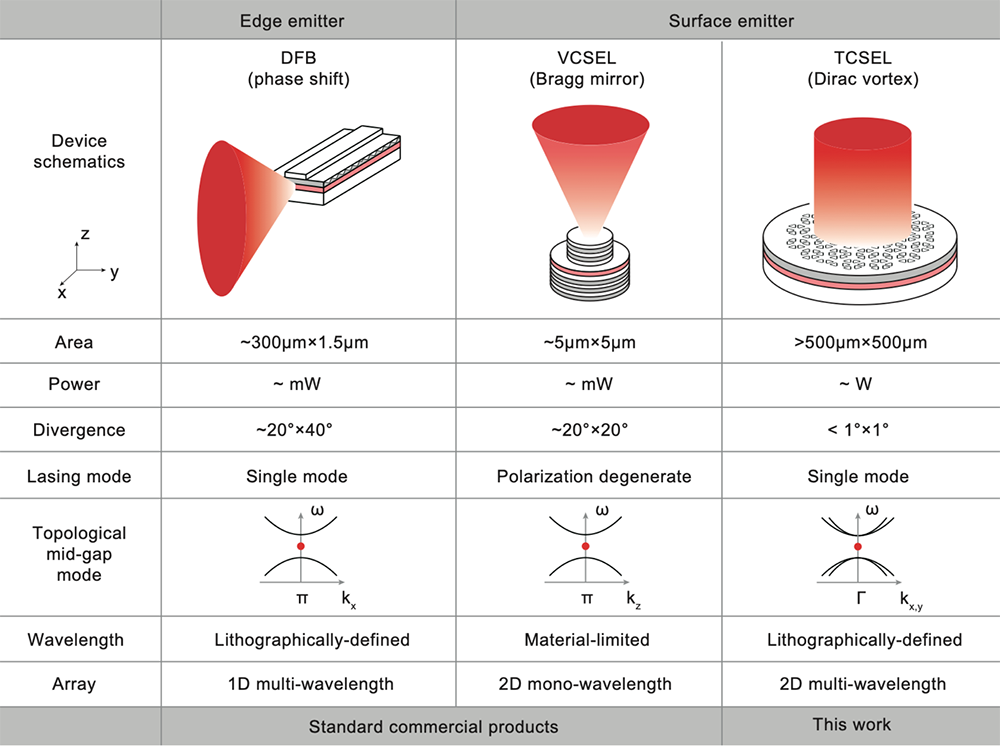Due to their small size, great efficiency, low price and wide spectral range, semiconductor lasers are the most extensively utilized lasers in our daily life. However, they have low output power and poor beam quality — two characteristics that are difficult to enhance simultaneously. A larger cavity, for instance, boosts power but also supports more modes to lase, which decreases beam quality.
 Figure 1. Comparison of TCSEL with mainstream commercial single-mode semiconductor lasers. Image Credit: Institute of Physics
Figure 1. Comparison of TCSEL with mainstream commercial single-mode semiconductor lasers. Image Credit: Institute of Physics
The L01 group at the Chinese Academy of Sciences’ Institute of Physics (CAS) led by Professor Ling Lu previously established a new cavity called a “Dirac-vortex topological cavity,” which delivers the best single-mode selection over the widest area. This cavity structure was developed to solve the above-mentioned semiconductor laser limitations while also improving output power and beam efficiency.
The same group recently extended their topological cavity to surface-emitting lasers, creating the topological-cavity surface-emitting laser (TCSEL), which outperforms commercial alternatives.
TCSEL produces 10 W peak power, sub-degree beam divergence, 60 dB side-mode suppression ratio, two-dimensional (2D) multiwavelength array, and lasing at 1,550 nm — the most critical communication and eye-safe wavelength. It can also work in any other wavelength range, making it suitable for a wide range of applications such as LiDAR for facial recognition, self-driving cars, and virtual reality.
The study was published in the journal Nature Photonics.
The researchers compared TCSEL to conventional single-mode semiconductor lasers used in industry. In their optimized 1D resonator designs, both the distributed feedback (DFB) edge-emitting laser used in Internet communication and the vertical-cavity surface-emitting laser (VCSEL) used in mobile phone face detection employ the mid-gap mode.
The 2D version of topological mid-gap mode, which is better suited for the planar process on semiconductor chips, is being developed by TCSEL.
The TCSEL has a unique characteristic called large area single mode, which boosts the power (>10 W) and beam divergence (<1°). The production of a single VCSEL is a few mW, whereas the output of a commercial DFB is approximately tens of mW — the usual divergence angle of surface emission is 20°, and the beam of the edge emitter is generally poorer.
The distinctive vortex structure from the Dirac-vortex cavity may be seen clearly according to the optical microscope and scanning electron microscopy pictures with a diameter of 500 m. The TCSEL far field is a radial polarization vector beam. Significantly, without collimating lenses, such a tiny divergence (sub-1°) of TCSEL can minimize the size of the system, complexity and cost in systems like 3D sensing.
Another distinguishing aspect of TCSEL is its wavelength adaptability, which allows for monolithic 2D multi-wavelength arrays. In contrast, since the vertical cavity that determines the lasing wavelength is epitaxy raised, VCSELs generally lack wavelength configuration. Although the wavelength of a DFB laser can be adjusted, it can only accomplish a 1D multi-wavelength array for edge emission.
TCSEL, on the other hand, can have its wavelength altered at will during the planar fabrication process. The matching laser wavelength in Figure 2 changes linearly from 1,512 nm to 1,616 nm as the lattice constant is changed. Each 2D array laser operates in a single mode with a side mode suppression ratio higher than 50dB.
The wavelength-division multiplexing technique for high-capacity signal transfer and multi-spectral sensing applications could benefit from the 2D multi-wavelength TCSEL arrays.
Since the emergence of the quantum Hall effect, topological physics has been the center of fundamental study, earning three Nobel prizes in physics (1985, 1998, 2016). Although topological resilience has the potential to dramatically improve device stability and parameters, topological physics has yet to be implemented. TCSEL has the potential to change everything.
CAS, the Beijing Natural Science Foundation, the Ministry of Science and Technology of China, and the Natural Science Foundation of China all contributed to this research.
Journal Reference:
Yang, L., et al. (2022) Topological-cavity surface-emitting laser. Nature Photonics. doi.org/10.1038/s41566-022-00972-6.